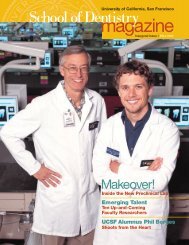Acknowledgements - UCSF School of Dentistry - University of ...
Acknowledgements - UCSF School of Dentistry - University of ...
Acknowledgements - UCSF School of Dentistry - University of ...
You also want an ePaper? Increase the reach of your titles
YUMPU automatically turns print PDFs into web optimized ePapers that Google loves.
#48 Title: Bedside to bench and back: BMP6 in bone formation<br />
W YU, J S LEE<br />
<strong>UCSF</strong> Department <strong>of</strong> Oral & Maxill<strong>of</strong>acial Surgery<br />
Objectives: Aging is a complex process that leads to decreased bone mass, healing and regeneration. In this study we examined<br />
the rib graft model to quantitatively determine the effects <strong>of</strong> age on clinical bone regeneration. Our aims were to examine the<br />
molecular mechanisms <strong>of</strong> age on postnatal bone regeneration and establish an in vivo model.<br />
Methods: Twelve patients were enrolled in a CHR-approved study and obtained a baseline CT immediately after a rib graft<br />
procedure and a CT 6-months later. Bone marrow stromal cells (BMSCs) were harvested from the patients and characterized (CFUf,<br />
differentiation, proliferation). mRNA from the BMSCs were extracted and microarray analysis performed. BMSCs were<br />
transplanted into young and old immunocompromised mice for 8 weeks to analyze the influence <strong>of</strong> the host environment.<br />
Results: We identified a statistically significant inverse correlation between regenerated bone volume and the age <strong>of</strong> the patients.<br />
We also found that CFU-f number decreased with age. The other in vitro characteristics did not correlate with age with statistically<br />
difference. Interestingly, the microarray data demonstrated that BMP6 expression in BMSCs was positively correlated with patients’<br />
age. When the cells were transplanted into the young and old mice, BMSCs, regardless <strong>of</strong> the age <strong>of</strong> the stem cell source,<br />
regenerated more bone in the young host compared to the old. BMP6 was found to be upregulated in BMSCs retrieved from the<br />
transplants in the old mice similar to the clinical human correlation.<br />
Conclusion: In this study, we recapitulated the influence <strong>of</strong> the aged host environment on bone regeneration. Our results suggest<br />
that bone regenerative capability decreases with advancing age possibly due to decreased stem cell number. However, the host<br />
environment impacts BMSCs differentiation ability via BMP6 regulation.<br />
Support: The work was funded by <strong>UCSF</strong> Dean’s Creativity Fund and AAOMS Oral & Maxill<strong>of</strong>acial Surgery Foundation Grant.<br />
IV. FACULTY<br />
#49 Title: Long-term Outcomes <strong>of</strong> a Program to Increase Dental <strong>School</strong> Enrollment <strong>of</strong> Economically Disadvantaged and<br />
Underrepresented Minority Students: The Dental Post-Baccalaureate Program<br />
H BRODY (1), C WIDES (1), C ALEXANDER (2), S GANSKY (1), E MERTZ (1)<br />
(1) <strong>University</strong> <strong>of</strong> California San Francisco, (2) <strong>University</strong> <strong>of</strong> California Los Angeles<br />
Objectives: The <strong>University</strong> <strong>of</strong> California, San Francisco <strong>School</strong> <strong>of</strong> <strong>Dentistry</strong> established the Dental Post-baccalaureate Program in<br />
1998 to provide reapplication assistance to students from economically and/or educationally disadvantaged backgrounds who were<br />
denied admission to dental school. The Program’s goals were to improve the diversity <strong>of</strong> the dental workforce and to improve<br />
access to care for the underserved. This paper seeks to assess the Program outcomes and practice patterns <strong>of</strong> <strong>UCSF</strong> Postbaccalaureate<br />
Program participants.<br />
Methods: Data on the participants’ pre/post DAT scores were collected from the Program along with post-Program dental school<br />
admission results to assess the short- and mid-term Program outcomes. Data were analyzed using a pre/post design <strong>of</strong> paired ttests<br />
and Wilcoxon signed rank tests to assess changes in numeric DAT scores. To assess longer term outcomes, participants who<br />
had completed dental school and had been in practice for at least two years were surveyed between 2009-2011 to ascertain their<br />
practice patterns. The survey had a response <strong>of</strong> rate <strong>of</strong> 94%. Descriptive statistical techniques were used to examine the responses<br />
and compared to nationally available practice data for new dental graduates.<br />
Results: Participants increased their DAT scores by an average <strong>of</strong> 2 points, and 98% <strong>of</strong> the participants were accepted to dental<br />
school. All <strong>of</strong> the respondents are practicing dentistry, and 81% are working with an underserved population. Their patient<br />
population is much more diverse than the general population, and 52% <strong>of</strong> these providers accept Medicaid patients.<br />
Conclusions: The short-, mid-, and long-term outcomes for the Post-baccalaureate Program’s participants demonstrate the overall<br />
success <strong>of</strong> the Program's goals <strong>of</strong> improving access for underserved populations and improving the diversity <strong>of</strong> the dental school<br />
population.<br />
Support: Award # P30DE020752 from the National Institute <strong>of</strong> Dental & Crani<strong>of</strong>acial Research.<br />
#50 Title: Disparities in Oral Health Status During Pregnancy<br />
L H CHUNG (1), J CHENG (1), J GONZALEZ (1), S A ADAMS (2)<br />
(1) <strong>UCSF</strong> Department <strong>of</strong> Preventive and Restorative Dental Sciences (2) Dept <strong>of</strong> Pediatrics, <strong>School</strong> <strong>of</strong> Medicine<br />
Objective: Pregnancy presents unique challenges to good oral health (OH) -increased gingival inflammation, limited access to<br />
dental care- putting women and their infants at increased risk for developing dental problems. This research examines oral hygiene<br />
practices, dental service use, and OH status during pregnancy using baseline data from an ongoing study, CenteringPregnancy®<br />
Oral Health Promotion (CPOP).<br />
Methods: CPOP is a pilot study (n=99) testing an educational intervention that aims to promote maternal and infant OH in pregnant<br />
women attending a group prenatal care program, CenteringPregnancy® (CP®), many <strong>of</strong> whom come from underserved<br />
communities. Baseline assessment <strong>of</strong> women from 4 San Francisco CP® sites during their 2nd trimester <strong>of</strong> pregnancy included a<br />
dental exam and questionnaire. Exam data (n=94) included full mouth periodontal probing, bleeding on probing, and visual<br />
<strong>School</strong> <strong>of</strong> <strong>Dentistry</strong> Research and Clinical Excellence Day 2011 Program 22




